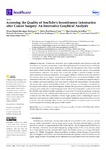Mostrar o rexistro simple do ítem
Assessing the quality of YouTube’s incontinence information after cancer surgery: an innovative graphical analysis
| dc.contributor.author | Rodríguez-Rodríguez, Álvaro Manuel | |
| dc.contributor.author | De la Fuente-Costa, Marta | |
| dc.contributor.author | Escalera-de la Riva, Mario | |
| dc.contributor.author | Domínguez-Navarro, Fernando | |
| dc.contributor.author | Pérez-Domínguez, Borja | |
| dc.contributor.author | Paseiro-Ares, Gustavo | |
| dc.contributor.author | Casaña, José | |
| dc.contributor.author | Blanco-Díaz, María | |
| dc.date.accessioned | 2024-05-24T06:39:42Z | |
| dc.date.available | 2024-05-24T06:39:42Z | |
| dc.date.issued | 2024-01-18 | |
| dc.identifier.citation | Rodriguez-Rodriguez AM, De la Fuente-Costa M, Escalera-de la Riva M, Domínguez-Navarro F, Perez-Dominguez B, Paseiro-Ares G, Casaña-Granell J, Blanco-Diaz M. Assessing the Quality of YouTube's Incontinence Information after Cancer Surgery: An Innovative Graphical Analysis. Healthcare (Basel). 2024 Jan 18;12(2):243. | es_ES |
| dc.identifier.issn | 2227-9032 | |
| dc.identifier.uri | http://hdl.handle.net/2183/36603 | |
| dc.description.abstract | [Abstract] Background: Prostate and colorectum cancers rank among the most common cancers, and incontinence is a significant postsurgical issue affecting the physical and psychological well-being of cancer survivors. Social media, particularly YouTube, has emerged as a vital source of health information. While YouTube offers valuable content, users must exercise caution due to potential misinformation. Objective: This study aims to assess the quality of publicly available YouTube videos related to incontinence after pelvic cancer surgery. Methods: A search on YouTube related to "Incontinence after cancer surgery" was performed, and 108 videos were analyzed. Multiple quality assessment tools (DISCERN, GQS, JAMA, PEMAT, and MQ-VET) and statistical analyses (descriptive statistics and intercorrelation tests) were used to evaluate the characteristics and popularity, educational value, quality, and reliability of these videos, relying on novel graphical representation techniques such as Sankey and Chord diagrams. Results: Strong positive correlations were found among quality rating scales, emphasizing agreement. The performed graphical analysis reinforced the reliability and validity of quality assessments. Conclusions: This study found strong correlations among five quality scales, suggesting their effectiveness in assessing health information quality. The evaluation of YouTube videos consistently revealed "high" quality content. Considering the source is mandatory when assessing quality, healthcare and academic institutions are reliable sources. Caution is advised with ad-containing videos. Future research should focus on policy improvements and tools to aid patients in finding high-quality health content. | es_ES |
| dc.language.iso | eng | es_ES |
| dc.publisher | MDPI | es_ES |
| dc.relation.uri | https://doi.org/10.3390/healthcare12020243 | es_ES |
| dc.rights | Creative Commons Attribution 4.0 International License (CC-BY 4.0) | es_ES |
| dc.rights.uri | http://creativecommons.org/licenses/by/3.0/es/ | * |
| dc.subject | DISCERN | es_ES |
| dc.subject | GQS | es_ES |
| dc.subject | JAMA | es_ES |
| dc.subject | MQ-VET | es_ES |
| dc.subject | Sankey | es_ES |
| dc.subject | YouTube | es_ES |
| dc.subject | Cancer | es_ES |
| dc.subject | Chord | es_ES |
| dc.subject | Diagram | es_ES |
| dc.subject | Incontinence | es_ES |
| dc.subject | Information | es_ES |
| dc.subject | Quality | es_ES |
| dc.subject | Surgery | es_ES |
| dc.title | Assessing the quality of YouTube’s incontinence information after cancer surgery: an innovative graphical analysis | es_ES |
| dc.type | info:eu-repo/semantics/article | es_ES |
| dc.rights.access | info:eu-repo/semantics/openAccess | es_ES |
| UDC.journalTitle | Healthcare | es_ES |
| UDC.volume | 12 | es_ES |
| UDC.issue | 2 | es_ES |
| UDC.startPage | 243 | es_ES |
| dc.identifier.doi | 10.3390/healthcare12020243 |
Ficheiros no ítem
Este ítem aparece na(s) seguinte(s) colección(s)
-
GI-IPRF - Artigos [141]






